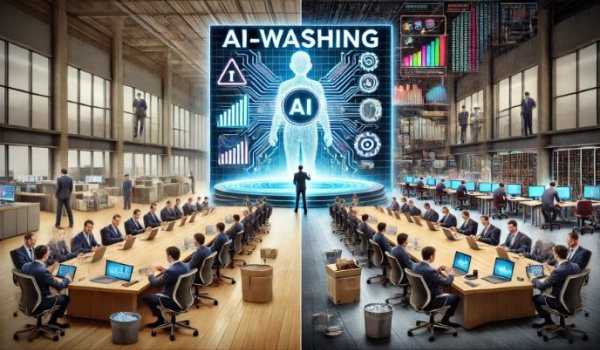Each week we find a new topic for our readers to learn about in our AI Education column.
This week we were inspired by our AI & Finance news column from last week to delve further into the concept of “AI-Washing”. And as per usual, we have a personal anecdote to share here, on how this technology works. If you’re a regular reader of this column, you know that we personally write the opener to our AI EDUCATION column weekly, and then turn it over the ChatGPT or another AI to write the meat of the topic’s content, the perfect marriage of (wo)man and machine. Once we’ve researched the AI content to confirm it’s accurate, we pretty much publish it as “written”, with minimal edits.
This week, we did a copy/paste of the AI News column referenced above (or thought we did), into our query for this content but we accidentally pasted from a different AI column on the Gen Z job market and how AI impacts that. And…..well…..huh. It wrote the piece from THAT context instead, and provided some pretty interesting insight on how AI-washing could alienate potential Gen Z employees. Fascinating, and we think quite insightful.
SO….read below and ponder it all. Well done, ChatGPT!
The Rise of AI-Washing: A New Frontier in Corporate Misrepresentation
In the ever-evolving landscape of technology and finance, buzzwords come and go, often leaving a trail of confusion and misrepresentation in their wake. One such term gaining traction is “AI-washing,” a phenomenon that mirrors the well-known concept of greenwashing. As institutions and corporations strive to stay ahead in a competitive market, the allure of artificial intelligence (AI) presents both opportunities and ethical dilemmas.
What is AI-Washing?
AI-washing refers to the practice of overstating or misrepresenting the extent to which a company uses or benefits from AI technologies. Much like greenwashing, where companies exaggerate their environmental credentials to appeal to eco-conscious consumers and investors, AI-washing involves presenting an image of being at the forefront of technological innovation without substantial evidence or implementation.
Companies engaged in AI-washing often employ vague or misleading language, using terms like “AI-driven,” “machine learning-powered,” or “cutting-edge AI solutions” without providing concrete details about how these technologies are integrated into their operations. This can mislead investors, customers, and other stakeholders about the company’s actual technological capabilities and future growth potential.
The Impact of AI-Washing
The implications of AI-washing are multifaceted. For investors, it creates a distorted view of a company’s innovative edge and potential for growth. This can lead to misinformed investment decisions, potentially resulting in financial losses. For customers, AI-washing can erode trust when the promised technological advancements fail to materialize, leading to dissatisfaction and reputational damage.
Furthermore, AI-washing can stifle genuine innovation. When companies can gain a competitive edge through marketing hype rather than actual technological development, there is less incentive to invest in meaningful research and development. This can slow the overall progress of AI technology and its beneficial applications across various industries.
Comparing AI-Washing to Greenwashing
Greenwashing has long been a concern in corporate social responsibility circles. Companies claiming to be environmentally friendly often engage in practices that are either minimal or unrelated to substantial environmental impact. AI-washing follows a similar pattern, where the claim of advanced technology masks a reality that is far less impressive.
Both practices exploit the gap between perception and reality. They rely on the audience’s lack of detailed understanding to create a favorable image. While greenwashing targets the growing demand for sustainable practices, AI-washing taps into the fascination and optimism surrounding AI. Both can lead to significant reputational risks if exposed, but AI-washing may also have broader implications for technological progress and market integrity.
AI-Washing in the Context of Job Market Trends
The phenomenon of AI-washing is particularly relevant when considering the modern job market, especially for younger generations. According to a recent article on Digital Wealth News, Gen Z job candidates are increasingly seeking purpose and passion in their careers, alongside financial rewards. This generation, known for its technological savviness, is particularly attracted to companies that demonstrate genuine innovation and social responsibility.
When companies engage in AI-washing, they risk alienating these potential employees. Gen Z candidates are likely to scrutinize claims about AI capabilities and seek roles in organizations that offer real technological engagement and ethical practices. Companies that fail to live up to their AI promises may find it challenging to attract and retain top talent from this discerning demographic.
Moving Forward: Ensuring Authenticity in AI Claims
For institutional investors and corporate leaders, it is crucial to foster an environment of transparency and authenticity regarding AI capabilities. Due diligence in evaluating AI claims should be rigorous, and companies should be encouraged to provide verifiable details about their technological implementations.
Moreover, regulatory bodies and industry groups can play a role in setting standards for AI claims, much like the certifications and guidelines developed for environmental sustainability. By promoting honest and substantiated representations of AI usage, the industry can avoid the pitfalls of AI-washing and support the genuine advancement of artificial intelligence.
In conclusion, AI-washing, like greenwashing, represents a significant challenge in today’s corporate landscape. It is essential for all stakeholders to remain vigilant and demand authenticity to ensure that the promise of AI technology is realized in meaningful and impactful ways.
ChatGPT and DWN







